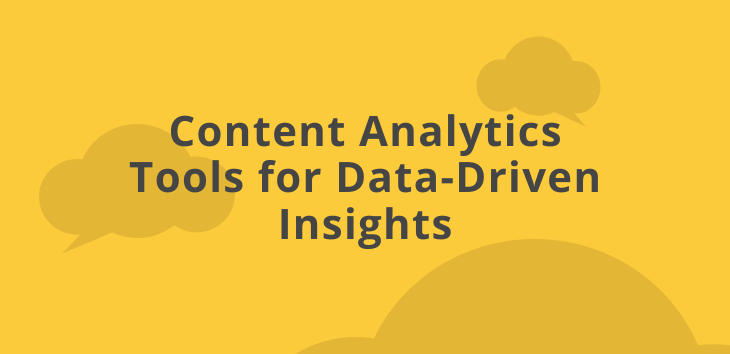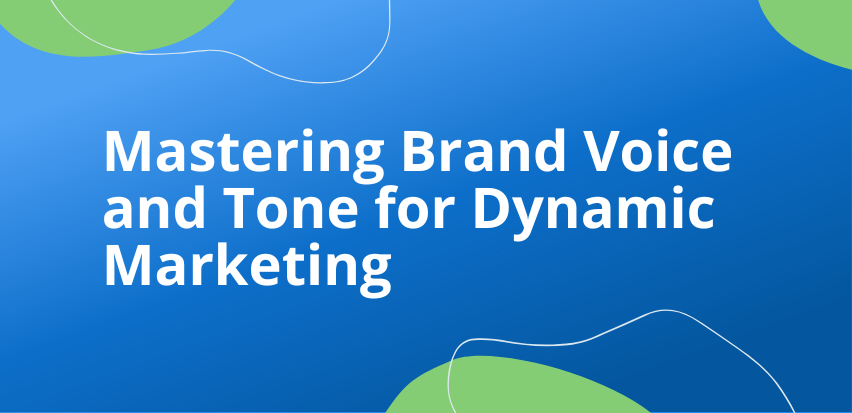Content analytics tools are essential for any writer or marketer looking to make their content stand out in a saturated online environment. While many people might think of content as just words on a page, data-driven strategies are crucial for creating successful and engaging content. In fact, 77% of marketers say that the importance of measurement, data, and analytics to their work will continue to increase in the coming years.
These platforms help gather and deliver valuable insights into audience behavior, keyword performance, and overall content effectiveness. To help leverage this intelligence, we evaluated some of the top content analytics software on the market. Read on to learn about available options, features, and pricing and how these tools can help refine your marketing strategies and boost the impact of your content.
Benefits of Content Analytics Tools
Sometimes, you might feel like you’re submerged in data. You’ve got stats flowing in from your website, social networks, marketing emails, paid ads, and influencer campaigns. How do you harness this data and make informed decisions about your digital strategy?
You could manually compile bits and pieces in a spreadsheet and attempt to find patterns and trends, but it’s more effective to use software built just for this purpose. Some benefits of using content analytics tools include:
- Efficiency: Content marketing analytics tools automate the gathering and processing of data, eliminating repetitive and time-consuming tasks. This lets you focus on interpreting the numbers rather than compiling them.
- Integration: Technology can streamline the process of gathering data, instantly pulling information from various channels.
- Accuracy: Automated platforms process large volumes of data with precision, eliminating human mistakes and inconsistencies in approaches.
- Versatility: You can segment data across channels, formats, and audiences to look at interactions from different perspectives and more accurately adapt your strategies.
- Artificial intelligence: Powerful content analytics tools leverage predictive analytics, machine learning, and AI-driven insights. In other words, by analyzing historical trends and learning as new information comes in, these tools can make your business highly responsive and competitive.
Essential Features for Content Analytics Tools
To choose a tool that meets your brand’s unique needs, consider what you want to achieve with your analytics. Common functionalities include:
- Insights into audience demographics and behaviors to help tailor content
- Engagement metrics to determine which content performs the best
- SEO analysis to help boost search visibility
- Competitor analysis to ensure you’re keeping up with similar websites
- Content optimization to help fine-tune content to better engage audiences
- Conversion tracking to evaluate how well you’re driving desired actions
- AI-powered analytics to personalize user experience and capitalize on predicted trends
Not all tools have the same robust features, so use our list below to narrow down possible options. Before making a final decision, read reviews from other users, consider scalability and integrations with your existing systems, and take advantage of free trials and demos to find a platform that’s a good fit for your business.
10 Content Analytics Tools: Features, Reviews, Prices, and More
It’s hard to single out one content analytics tool as being the best on the market. They all have different approaches. Some are all-in-one tools, and others aim for simplicity. Some focus on search visibility, and others zero in on user behavior or content engagement.
We looked at each tool’s strengths, unique features, and weaknesses and added in pricing information and user reviews. Here’s what we determined:
- Google Analytics: Best Tool for Audience Insights
- Semrush: Best Overall Content Marketing Analytics Platform
- Clarity: Best Software for Behavior-Focused Analytics
- Simple Analytics: Best Analytics Tool for Beginners
- SE Ranking: Best Platform for Local Search Analytics
- DYNO Mapper: Best Software for Content Audits
- Google Search Console: Best Tool for Search Engine Insights
- Parse.ly: Best Analytics Platform for Publishers
- ImpactHero: Best Software for Aligning Content With the Buyer Journey
- Fathom Analytics: Best Privacy-First Analytics Platform
Google Analytics
Best Tool for Audience Insights
We’ll lead off with a tool from the search engine giant. Google Analytics (GA) helps you understand who’s using your website and how they interact with the content. Simply place a tracking code on your site, and GA begins gathering data related to traffic, referral sources, and user engagement.
One advantage of GA is that it provides demographic information for users logged into their Google accounts, including age, gender, and interests. The platform can also track whether users complete desired actions, such as filling in forms or making purchases. Its machine learning capabilities can look at historical data to predict customer actions and churn.
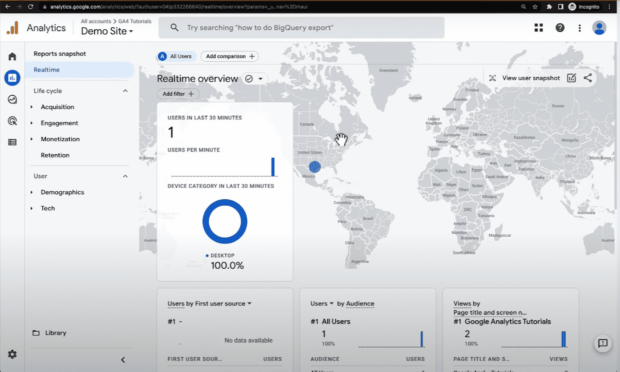
Pros
- Easy to set up
- Provides insight into user behaviors and interests
- Manages multiple properties, including apps
- Helps track return on investment
- Integrates with Google platforms, such as Search Console and Ads Manager
Cons
- Can be difficult to use
- Lacks robust customer support
- Data is aggregated, so you can’t track individual users
Special Features
While it’s easy to look at a graph and see sudden spikes or drops in data, GA’s Trend Change detection alerts you to subtle changes in the direction of your data over longer periods of time. It works by comparing a forecasted value to the actual value.
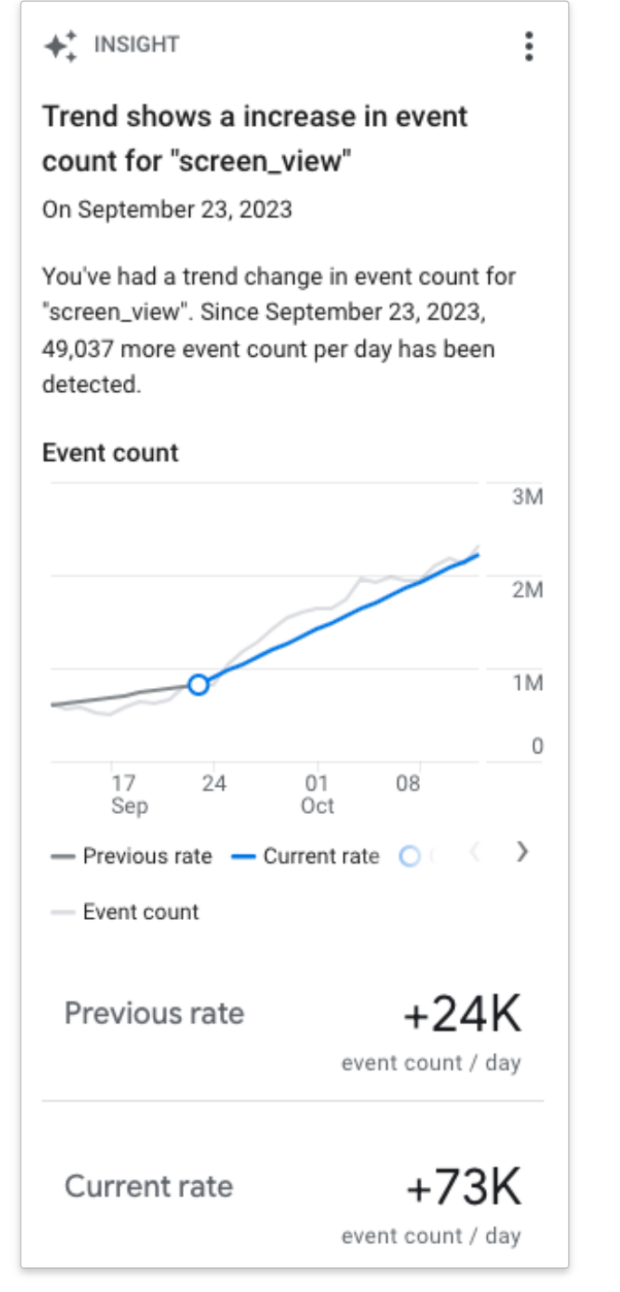
Pricing
- Free
What We’ve Heard
“Google Analytics is the biggest name in website and mobile app intelligence. It has a steep learning curve, but it is an awesome business intelligence tool.” – Pam Baker, PC Magazine
Use Cases and Best Practices
Use GA to get an overall picture of your user journey. You can segment data by content distribution channel (search engine, social media, paid ad, email) and get nuanced insights about audience experience. For example, if people arrive on your landing page through a paid ad but aren’t converting, the ad might not match expectations, or you may need to make the offer more clear.
Semrush
Best Overall Content Marketing Analytics Platform
Another leader in the SEO field is Semrush. Its comprehensive suite of digital marketing utilities ranges from keyword research tools to AI writing assistance. It’s especially powerful for tracking keyword rankings so you can identify content that needs more visibility. You can also set up alerts if your positioning changes for specific keywords or pages and use the share of voice metric to compare your visibility with other brands in your niche.
The tool also provides insight into how users engage with your content, including page views, time spent on page, click-throughs, conversions, and return on investment.
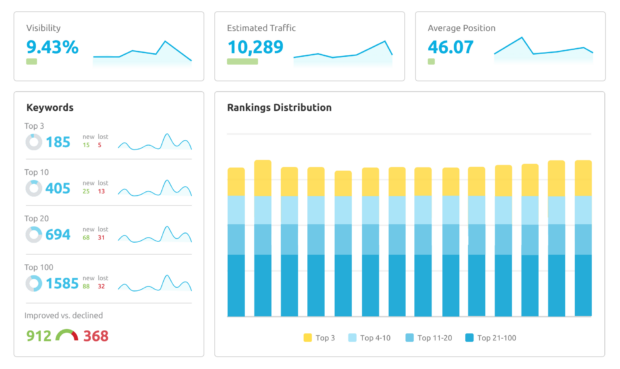
Pros
- All-in-one digital marketing platform with reports related to search engine, pay-per-click, and social media marketing
- Vast keyword research database with insight into search volume and difficulty
- Data on organic traffic, keyword rankings, backlinks, and social media engagement
- Integrates with Google products, social networks, and tools such as Monday.com and Wix to streamline workflow
Cons
- Vast amount of tools and data can make it hard to know what information is relevant
- Provides historical data only when you upgrade to Guru or Business Plan
- May be costly for some businesses
Special Features
Semrush’s On-Page SEO tracker analyzes your content and provides concrete ideas to improve organic traffic. The suggestions relate to content readability and helpfulness, as well as SEO factors, such as backlinks, technical issues, and user experience.
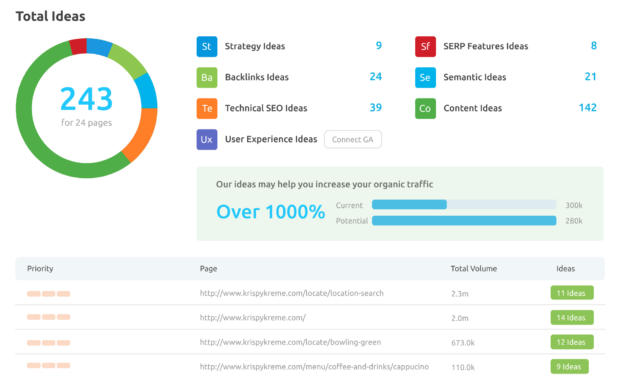
Pricing
- Pro: $129.95 monthly
- Guru: $249.95 monthly
- Business: $499.95 monthly
- 7-day free trial available
What We’ve Heard
“Semrush is used by both our marketing team and our editorial team. [Our] marketing team uses Semrush for paid and earned marketing research, competitive analysis, and tracking performance. Our editorial team uses multiple research and writing tools that help them make decisions about SEO.” – Melissa D. Cooper, TrustRadius review
Use Cases and Best Practices
Use Semrush for all stages of content marketing, including keyword research, competitor analysis, and content creation. You can then monitor your content’s performance in the SERPs, social media reach, and most visited pages to assess how well your content attracts audiences.
Microsoft Clarity
Best Software for Behavior-Focused Analytics
Your website metrics reflect how well you’re attracting traffic and the URLs your audiences are visiting, but what do users do when they’re actually on a page? Clarity uses advanced heat maps and session recordings to reveal how audiences interact with content on a page level. You can see where they click, how far they scroll before abandoning a page, and whether they click to another page but quickly return to the one they’re on. Best of all, Clarity is free.
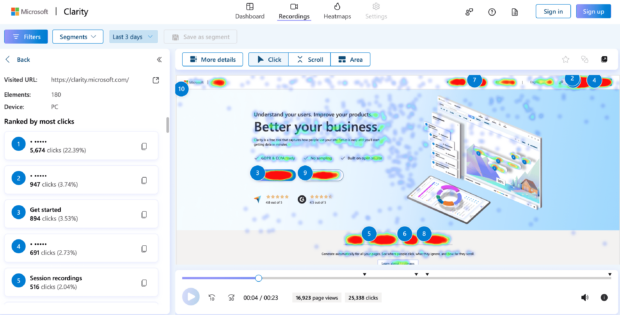
Pros
- Shows which areas of a page generate the most interaction
- Identifies where users get frustrated
- Records all sessions, not just a sampling
- Filters data by location, browser, campaign, or session duration
- Integrates with Shopify, Weebly, Wix, WordPress, Squarespace, and Unbounce
Cons
- Data is only retained for 30 days
- Can’t segment audiences
- Only provides click-and-scroll heat maps, not movement heat maps
Special Features
Clarity’s session recordings let you watch anonymized recordings to see how users navigate your web pages and when they abandon them. You can also detect issues, such as rage clicks — elements they try to click that aren’t links — and page errors. In addition to individual recordings, you can view a heat map aggregation.
Use these insights to fine-tune your content for better engagement. For example, if users aren’t scrolling deep into a page, revise your content to put more relevant information at the beginning. If they drop off without converting, consider a stronger call to action or more prominent buttons.
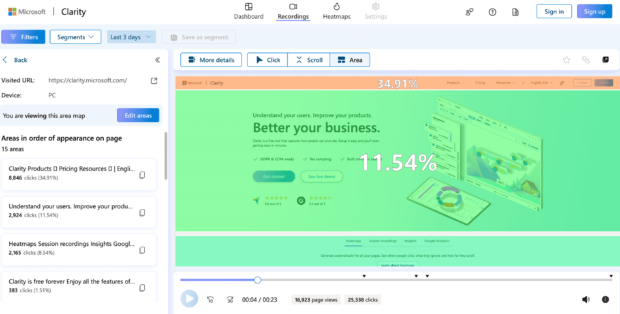
Pricing
- Free
What We’ve Heard
“Knowing how and where your user interacts most on your page gives you another level of on-page content and call-to-action optimization. Why have your best banner ads or action buttons in areas that turned out to be dead-space?” Olaf S., review on G2
Use Cases and Best Practices
For more powerful insights, connect Clarity to Google Analytics. This lets you view data on both platforms. You can watch playback links of relevant segments right in GA or check metrics from GA while you’re in Clarity.
Simple Analytics
Best Analytics Tool for Beginners
Like its name implies, Simple Analytics gets right to the point. Its straightforward user interface presents key metrics clearly. You can quickly monitor traffic, where your visitors come from, and the content they engage with.
Simple Analytics is also a privacy-first content analytics platform that doesn’t store personal data, which means you don’t need cookie banners on your site. Its lightweight script minimizes impact on your site speed. Because the tool doesn’t collect data, it doesn’t use machine learning or predictive analytics.
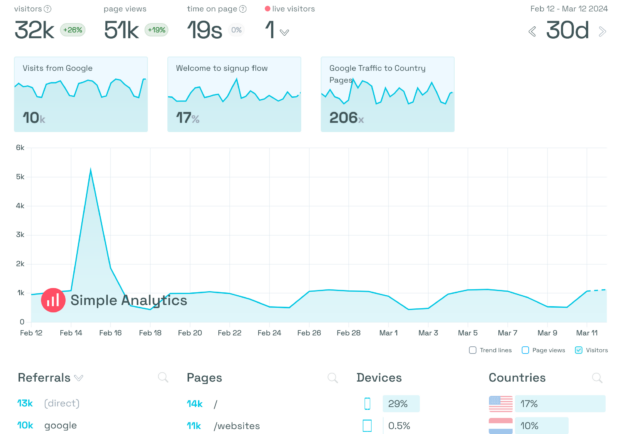
Pros
- Simplifies how you access data
- Measures traffic, referrals, top pages, page views, and time on page; and monitors devices, browsers, and countries
- Allows you to segment data to get a detailed picture of site visitors
- Provides AI chat for analytics questions
- Offers responsive customer support
- Imports data from Google Analytics
Cons
- Not as robust as other tools, but new utilities continue to roll out
Special Features
The tool’s AI chat helps you access your data more easily. Instead of trying to read reports and charts, for example, you can ask analytics questions in real time. For example, you can prompt the AI tool to compare traffic for different time periods or create a pie chart breaking down referral sources. The AI chat can also answer questions about using the tool’s features, which may be easier than searching the documentation.
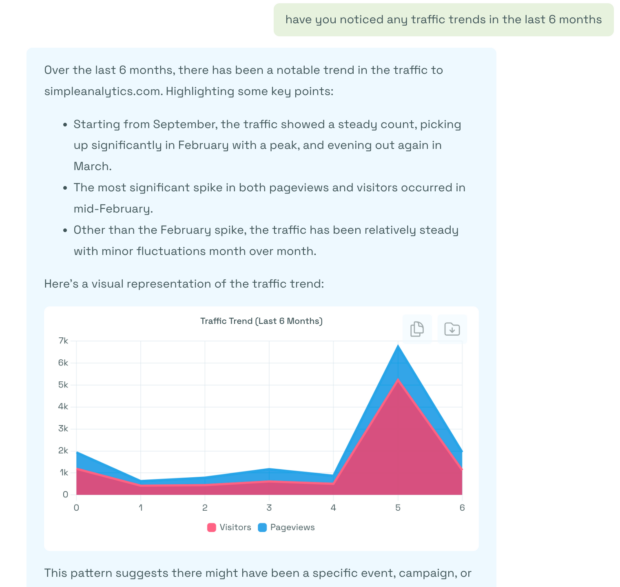
Pricing
- Starter: $9 monthly
- Business: $49 monthly
- Enterprise: Contact for pricing
- Free 14-day trial
What We’ve Heard
“It’s good to have raw data of the visits in the website and easy to implement the tracker/events. Also, it is really fast to adapt for those who [have] already used Google Analytics.” – Mateus A., GetApp review
Use Cases and Best Practices
Set up goals in the platform to determine if your content achieves key metrics or encourages conversions. A goal can be a certain amount of time spent on a page or an increase in free trials, for example. You can then use the Goal Tracker to monitor your progress and adjust your content if you’re falling short of your objectives.
SE Ranking
Best Platform for Local Search Analytics
SE Ranking may be a good fit if you’re looking for a straightforward tool to track search performance and optimize pages to boost visibility. Like Semrush, it provides keyword research, SEO monitoring, AI content creation, and on-page SEO tools.
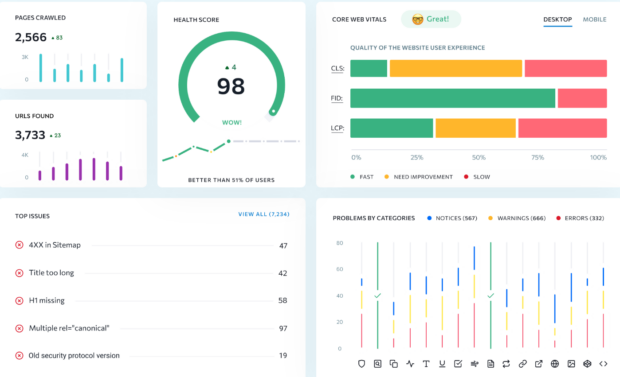
Pros
- Daily ranking updates
- Website audit for technical issues and Core Web Vitals
- Recommendations to improve content for relevance and user experience
- Insight into keyword density, word count, and readability metrics
- SERP analysis of competitors
- Easy-to-use interface
Cons
- Costs extra for some tools, even if you have a subscription
- Keyword database isn’t as large as some other tools
- Doesn’t track on-site metrics, such as page views, time spent on page, or session duration
Special Features
Although it’s an add-on, SE Ranking’s Local Marketing tool is worth mentioning. This tool is ideal for finding effective keywords and tracking rankings across multiple locations. You can see what search terms customers use to determine where you need to optimize your content. You can also manage reviews and check listings in different directories to improve local visibility.
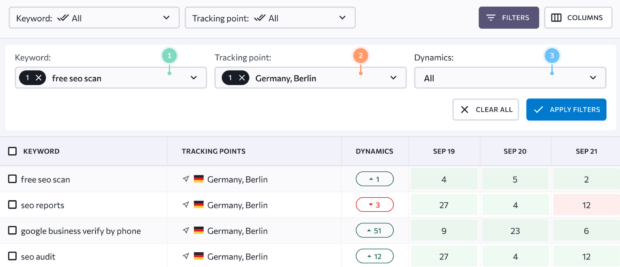
Pricing
- Essential: $44 monthly (Local Marketing add-on is $5.60 monthly)
- Pro: $87.20 monthly (Local Marketing add-on is $38.40 monthly)
- Business: $191.20 monthly (Local Marketing add-on is $144.80 monthly)
What We’ve Heard
“This all-in-one platform helps me view the bigger picture for analytics when it comes to web traffic and really understand how my clients’ sites are doing. I like that I can easily audit websites, add keywords and competitors, and then identify weak areas within their backlinking.” Hillary Glaser, TrustPilot review
Use Cases and Best Practices
SE Ranking monitors your performance on Google, Bing, Yahoo, YouTube, Google Maps, and Google Ads. You can identify content that needs improvement and make data-informed decisions based on backlinks, competitor results in the SERPs, and your site’s on-page SEO.
DYNO Mapper
Best Software for Content Audits
Before you can optimize your website, you need to understand its current structure. This can be challenging if you’ve been adding to your site ad hoc over the years. DYNO Mapper crawls and maps your site and provides you with a detailed inventory of its content assets. Once you have an overview of your catalog, you can begin pinpointing areas for improvement and filling in content gaps.
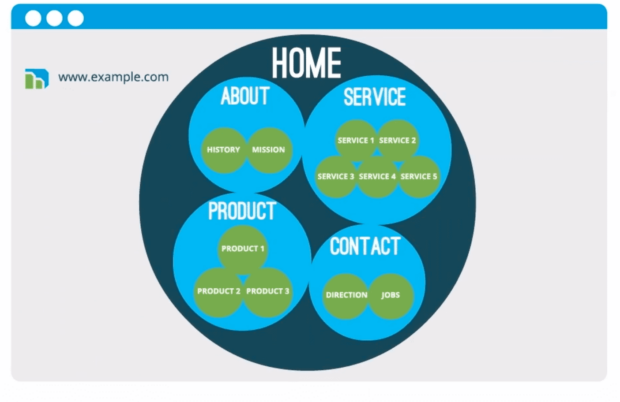
Pros
- Generates an interactive visual sitemap
- Catalogs subdomains, pages, images, videos, documents, and other files
- Audits your site for broken links, errors, and duplication in metadata
- Tracks keyword position in Google, Yahoo, and Bing
- Tests for accessibility issues
Cons
- Lacks concrete recommendations for improving search rankings
- No AI-powered insights or content creation tools
Special Features
DYNO Mapper integrates with Google Analytics. This lets you view important data on each page of your site map, such as sessions, users, page views, pages per session, bounce rate, and average session duration. It also pulls in your content inventory so you can see what assets are on each page.
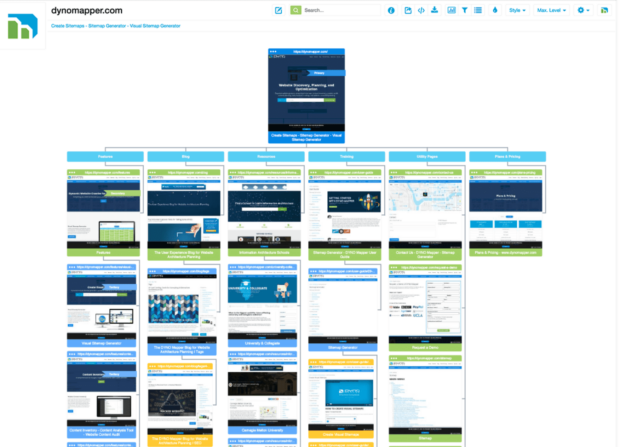
Pricing
- Lite: $39 monthly, billed annually
- Pro: $49 monthly, billed annually
- Standard: $99 monthly, billed annually
- Organization: $360 monthly, billed annually
What We’ve Heard
“Being able to see the sitemap visually allows everybody to see in a much clearer way how the site manages content. Premium features are great for SEO / Content Managers. Seeing keywords and pageviews is quite useful.” – Daniel R., G2 review
Use Cases and Best Practices
DYNO Mapper helps you visualize how your content is organized for search engines and users. Analyze the sitemap to ensure your site is logically structured for indexing and navigation. Then, use the inventory list to manage your content — check which URLs are ranking, ensure pages are relevant and up to date, and search your existing content before creating new pieces.
Google Search Console
Best Tool for Search Engine Insights
Google Search Console (GSC) ensures your pages are crawled and indexed so they appear in the SERPs. The tool measures search performance, such as rankings, impressions, and clicks. It also helps troubleshoot problems that can affect your search presence.
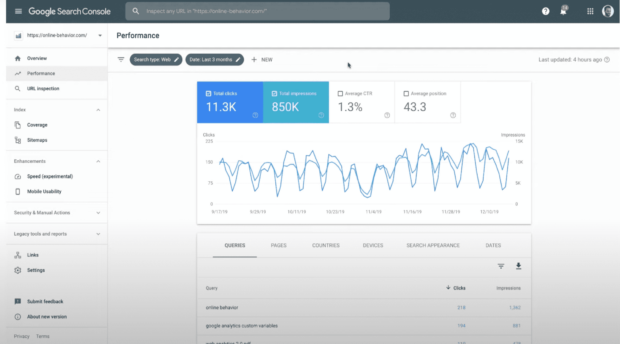
Pros
- Monitors changes in keyword position
- Measures your site’s technical health through Core Web Vitals
- Alerts you to crawl errors, manual penalties, and broken links
- Integrates with Google Analytics
Cons
- Data takes a few days to appear in GSC
- Historical data is limited to 16 months
Special Features
Your content won’t appear in the SERPs if issues prevent Googlebot from crawling it. GSC’s Page Indexing Report gives you a count of your total indexed and non-indexed pages. Regularly monitor this report to check for pages that aren’t crawled and why. Once you fix the issues, you can ask Google to try crawling it again to ensure your site has visibility.
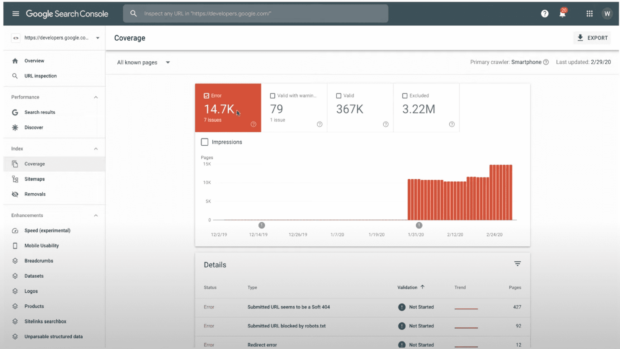
Pricing
- Free
What We’ve Heard
“This is the only truly reliable source of data for performance in Google’s organic search, from search impressions to a breakdown of countries where search users come from. This allows a site owner to better optimize their site’s content and structure to improve organic rankings, and increase click-through rates.” – Josh Bender, TrustRadius review
Use Cases and Best Practices
While you can use GSC as a standalone tool for tracking keyword position and visibility in the SERPs, you get more data when linking Search Console to Google Analytics. This combined data gives you access to Search Console’s Insights report, which is a snapshot of your overall content performance. It shows at a glance which pages are most successful, what audiences search for before they visit your site, and which websites refer visitors to your domain. You can also track the performance of newly published content.
Parse.ly
Best Analytics Platform for Publishers
Parse.ly analyzes website metrics from the perspective of content performance, making it an ideal tool for content marketers and media sites. The tool tracks user engagement with content in a variety of ways, including by topic, section, author, campaign, channel, and publication date. As a bonus, it also promotes itself as an analytics platform that doesn’t require a data analyst to use. The easy-to-use platform allows you to focus your energies on your content strategy.
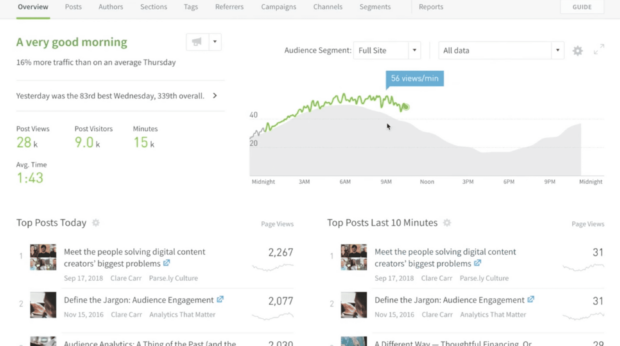
Pros
- Tracks page views, unique visitors, engaged time, and conversions
- Offers geo-segmentation for insight into content preferences of international audiences
- Segments users by group, such as subscribers and members
- Tags content automatically using AI
- Provides video analytics to gauge the success of embedded videos and video topics
- Intuitive and easy to use
Cons
- Historical data is available for only 13 months
- Pricing isn’t available on website
Special Features
Parse.ly leverages data aggregation, predictive analytics, and machine learning to help you identify content trends. You can determine the metrics that indicate a trend — page views or conversions, for example. You can also set the time frame for monitoring the trend, such as months, days, or even half-hour intervals. Parse.ly alerts you when it detects a trend so you can act on it.
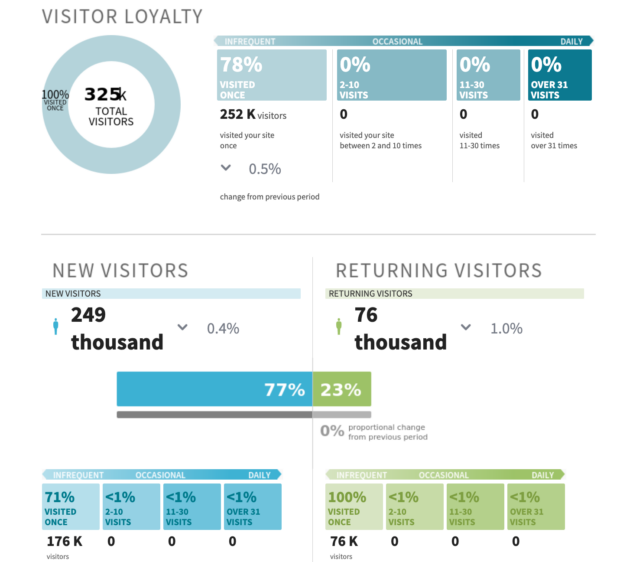
Pricing
- Three different plans are available, but you must book a demo to learn about pricing
What We’ve Heard
“Parse.ly allows us to dive into articles categorized by tags, as well as authors, and see not only traffic but where that traffic is being referred from, e.g., Google, AMP, and social networks. All of this gives a better indication of how to respond both to the performance of singular articles and on a wider scale.” – Alice Marshall, Trust Radius review
Use Cases and Best Practices
Use Parse.ly to dig deeper into traditional metrics, such as page views and time spent on a site. The tool puts the metrics in the context of content types and audience segments. For example, you might compare content read by new visitors to content read by returning visitors. These insights can inform your content production process so you can create more relevant content.
Parse.ly’s Content Conversions tool also helps you better determine the ROI of your content. You can specify events to track, such as sign-ups, downloads, or purchases, and attribute them to your content. For example, you can track the last page a user visited before they completed an action.
ImpactHero
Best Software for Aligning Content With the Buyer Journey
An effective content strategy provides audiences with the exact information they’re looking for at each stage of their path to purchase. ImpactHero helps you plan content according to the buyer journey. It monitors how well your content performs and uses AI to help you improve it. This tool is powered by Semrush and can be used as part of the SEO platform or a standalone.
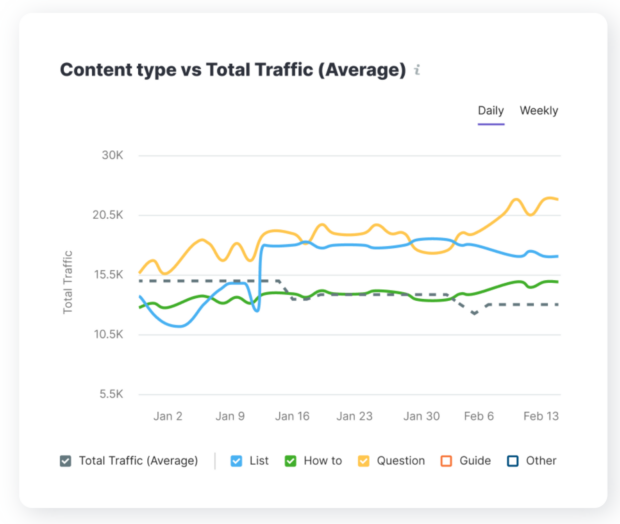
Pros
- Streamlines analytics for content teams
- Provides automated distribution of content according to funnel stage
- Shows where users are abandoning your site so you can refine the content
- Measures impact of content on conversion
- Provides AI-generated recommendations to improve content effectiveness at each stage
Cons
- Price may be costly for many businesses
Special Features
Using artificial intelligence, ImpactHero maps your customer journey to help you visualize how users interact with your site. It breaks down performance by content types, such as lists, tutorials, questions, and guides. You can also segment by traffic sources to see which channels provide the most engagement.

Pricing
- $200 monthly
- Free trial available
What We’ve Heard
“ImpactHero helps us measure results and pivot to ensure we’re accomplishing what we’ve set out to do — engage and convert website visitors. We can now see the complete content user journey and identify new ways to convert website visitors.” – Debra B. McCraw, ImpactHero review
Use Cases and Best Practices
One of the most useful ways to leverage the platform is to choose a funnel stage: content that attracts visitors (attraction), content that keeps visitors on the site and builds loyalty (impact), and content that inspires action (conversion). You can then analyze metrics such as traffic, engagement, bounce rate, leads, and conversions. ImpactHero’s algorithms suggest ways to optimize content for each stage to help you build a cohesive overall strategy.
Fathom Analytics
Best Privacy-First Analytics Platform
Fathom Analytics positions itself as an alternative to Google Analytics. Like Simple Analytics, it delivers key website data, such as traffic, views, referral sources, and conversions, focusing on ease of use. It also emphasizes digital privacy, tracking website usage without collecting personal data, such as IP addresses. Fathom is compliant with many privacy laws, including GDPR and CCPA.
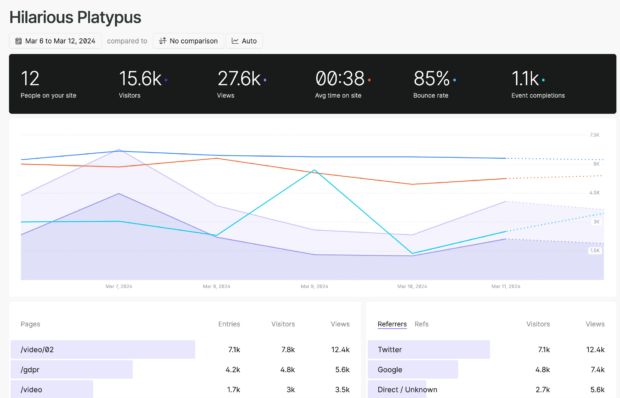
Pros
- Blocks bots, scrapers, and spam for more accurate data
- Anonymizes data without the use of cookies
- Tracks conversions, such as sales, clicks, and sign-ups
- Imports historical Google Analytics data and saves it indefinitely
- Provides email reports so you can share information easily with colleagues
Cons
- Doesn’t provide keyword rankings or SEO analysis
- Lacks AI optimization
- May not have enough functionality for some businesses
Special Features
Fathom’s defining feature is its simplicity: a single-page dashboard that gives you an overall picture of your site performance. You can see key metrics for any time period, including visitors, views, bounce rate, event completions, average time on site, referring sources, browsers, devices, and countries.
To drill into details, click on the elements you’re interested in. For example, you can filter data to learn about visitors from Reddit on mobile devices from the United Kingdom. You can add up to 10 filters.
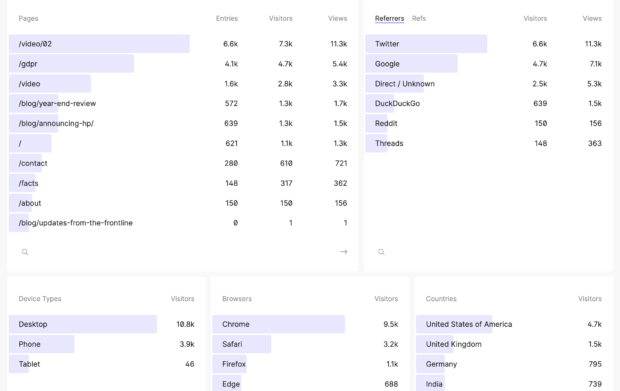
Pricing
- $15 monthly for up to 100,000 data points (page views and events)
- Tiered pricing based on monthly data points
- 30-day free trial
What We’ve Heard
“Simple user interface, no GDPR banners required, easy light-weight loading script, privacy-focused, and I own the data!” – Jess J. review on G2
Use Cases and Best Practices
While Fathom’s single-screen dashboard lets you see common metrics, such as traffic and top pages, at a glance, you can customize data by setting up events. These are specific actions that provide insight into how customers are interacting with your content.
You can track form submissions, free trials, and purchases. You can even track different clicks to see what users are more drawn to. Do they use breadcrumb or sidebar navigation? Are they clicking through slideshows? Downloading PDFs?
Content Analytics Tools Overview
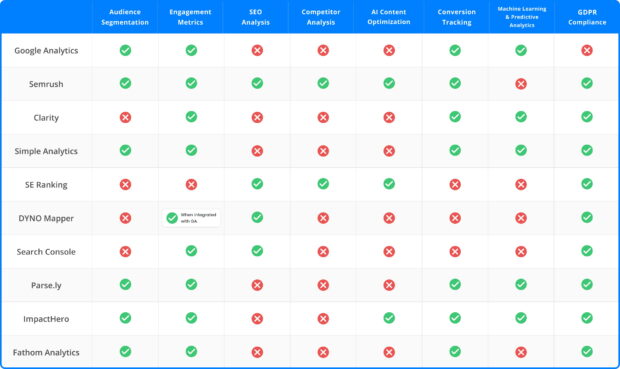
Drive Your Business Forward With Content Analytics Tools
Content analytics tools are an essential part of modern content strategies, helping you gather intelligence to make informed decisions. Bolstered by AI and machine learning, these platforms are increasingly more powerful, guiding you to your audiences with precision.
Now is the time to incorporate these tools into your workflow if you want to gain a competitive edge. According to a study by Adobe, just 37% of underperforming organizations have the data they need to understand their customers, while 61% of leading organizations are already putting data to work. The sooner you can leverage analytics in your content strategy, the greater advantage you’ll have over your competitors.
Crowd Content can help you translate your data insights into finely tuned content that’s optimized for search visibility, appeals to readers, and propels your business toward its goals. Contact us today to learn more about our SEO content writing services.
